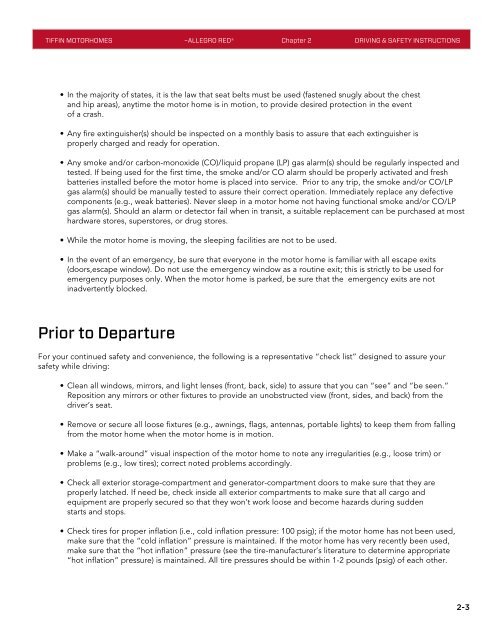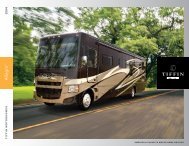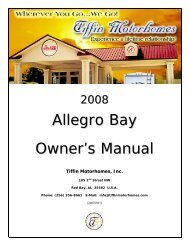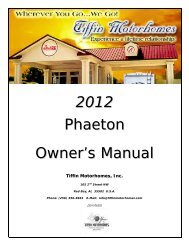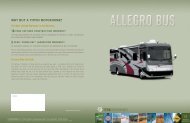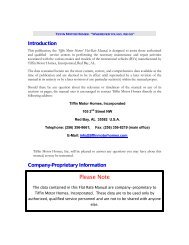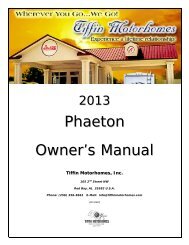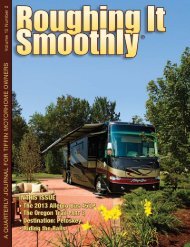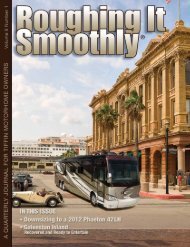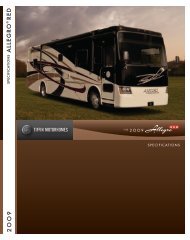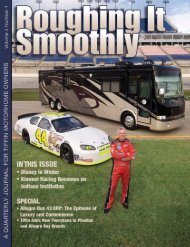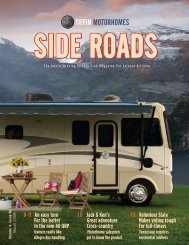Allegro RED Owner's Manual - Tiffin Motorhomes
Allegro RED Owner's Manual - Tiffin Motorhomes
Allegro RED Owner's Manual - Tiffin Motorhomes
- No tags were found...
You also want an ePaper? Increase the reach of your titles
YUMPU automatically turns print PDFs into web optimized ePapers that Google loves.
TIFFIN MOTORHOMES –ALLEGRO <strong>RED</strong>® Chapter 2 DRIVING & SAFETY INSTRUCTIONS• In the majority of states, it is the law that seat belts must be used (fastened snugly about the chestand hip areas), anytime the motor home is in motion, to provide desired protection in the eventof a crash.• Any fire extinguisher(s) should be inspected on a monthly basis to assure that each extinguisher isproperly charged and ready for operation.• Any smoke and/or carbon-monoxide (CO)/liquid propane (LP) gas alarm(s) should be regularly inspected andtested. If being used for the first time, the smoke and/or CO alarm should be properly activated and freshbatteries installed before the motor home is placed into service. Prior to any trip, the smoke and/or CO/LPgas alarm(s) should be manually tested to assure their correct operation. Immediately replace any defectivecomponents (e.g., weak batteries). Never sleep in a motor home not having functional smoke and/or CO/LPgas alarm(s). Should an alarm or detector fail when in transit, a suitable replacement can be purchased at mosthardware stores, superstores, or drug stores.• While the motor home is moving, the sleeping facilities are not to be used.• In the event of an emergency, be sure that everyone in the motor home is familiar with all escape exits(doors, escape window). Do not use the emergency window as a routine exit; this is strictly to be used foremergency purposes only. When the motor home is parked, be sure that the emergency exits are notinadvertently blocked.Prior to DepartureFor your continued safety and convenience, the following is a representative “check list” designed to assure yoursafety while driving:• Clean all windows, mirrors, and light lenses (front, back, side) to assure that you can “see” and “be seen.”Reposition any mirrors or other fixtures to provide an unobstructed view (front, sides, and back) from thedriver’s seat.• Remove or secure all loose fixtures (e.g., awnings, flags, antennas, portable lights) to keep them from fallingfrom the motor home when the motor home is in motion.• Make a “walk-around” visual inspection of the motor home to note any irregularities (e.g., loose trim) orproblems (e.g., low tires); correct noted problems accordingly.• Check all exterior storage-compartment and generator-compartment doors to make sure that they areproperly latched. If need be, check inside all exterior compartments to make sure that all cargo andequipment are properly secured so that they won’t work loose and become hazards during suddenstarts and stops.• Check tires for proper inflation (i.e., cold inflation pressure: 100 psig); if the motor home has not been used,make sure that the “cold inflation” pressure is maintained. If the motor home has very recently been used,make sure that the “hot inflation” pressure (see the tire-manufacturer’s literature to determine appropriate“hot inflation” pressure) is maintained. All tire pressures should be within 1-2 pounds (psig) of each other.2-3


